13th March 2013
Browsing Around Mutrah with its Souq, and a Visit to the Sultan's Palace in Old Muscat
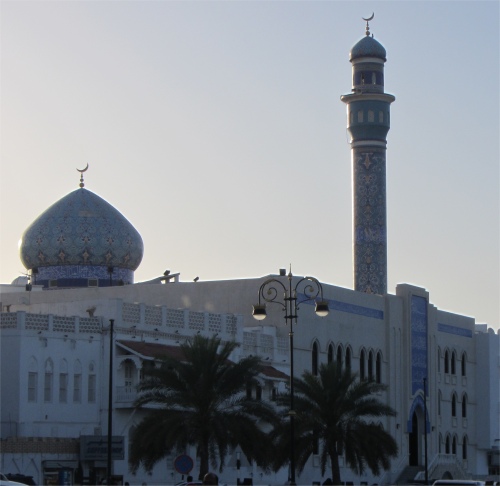
Mutrah's Al Rasool Al Azam Mosque
|
My top priority today was to bottom out a couple of trips I wanted to take up into the Hajar Mountains. These were the sort of trips where a guide and a 4x4 were essential. I had spent a while yesterday negotiating with an outfit, trying to get a like-minded traveller organised so that costs could be shared. There was a danger that it could take a while to line up a fellow traveller, and I could miss my window of opportunity altogether. So I bit the bullet and arranged to pay over the odds. With my major explorations sorted, I could now breathe more easily and take other sights in at my leisure.
My plan for the day was to visit Mutrah, then walk along the coast to Old Muscat and explore there.
In cooler climes I would have walked the few miles from Ruwi to Mutrah, but by mid-morning the atmosphere was like an oven. I took the easy way out and hired a cab to Mutrah. The driver was a friendly chap, but being of Arabic descent, the conversation was a little stilted. I found the Indians here had a better command of my native tongue. My current Arabic was limited to about ten words and expressions.

Trumpet Fish
|
He dropped me off on the Mutrah Corniche. Muscat means "anchorage", and the sea continues to constitute a major part of the city. As one of largest sea ports of the region, Mutrah is a centre of commerce, but it had the air of a fishing village. Men and boys stood by the harbour wall, trying to catch trumpet fish, with minimal success. Across the glistening blue waters, in the main pool, cruise ships snuggled to the quays, resting their weary engines before the next leg of their Arabian journey. Gulls lazily dipped their wings and snatched tiddlers from the rippled surface. A couple of old dhows dancing around their anchors providing a reminder to the port's past.
|
|
Mutrah Harbour (please use scroll bar)
|
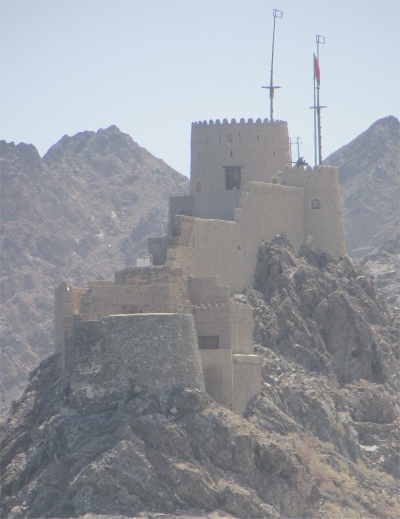
Mutrah Fort
|
A long row of white buildings and mosques sat alongside the coastal road, all gleaming under the harsh sunlight. A couple of cafes provided a focal point for umpteen coaches that disgorged the scores of cruise ship passengers, some of whom grabbed the nearest table, while other more adventurous types dived into the nearby souq.
I left the fishermen to their idle sport, crossed the busy road, and joined the happy throng in the souq, entering via the Gold Souq. I am not into jewellery, but I was taken aback by the multitude of small shops literally dripping with gold, so much so that the store interiors seemed to emanate a positive golden glow. Other shops focussed on silver or jewels, but it was the gold stores that cruise folk dwelled at.
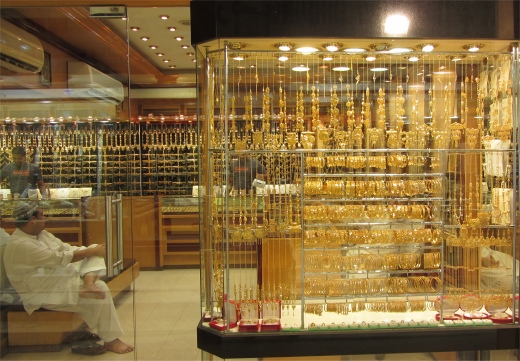
Gold Souq
|
Some shops concentrated on frankincense from Dhofar, the wafts enticing passers-by, other antique shops sold a mixture of Indian and Omani artefacts ranging from intricate small decorated wooden boxes, to ornamental urns, pots and Khanjars, the traditional curved daggers. One store had a magnificent display of mandoos outside which I found fascinating. There are, or were said to be, three pieces of furniture in an Omani house: "The doors, the windows and an Omani chest". Actually there are several types of Omani Chest but perhaps the main character is the Omani Mandoos or Wedding Dowry Chest (Hope Chest). Seafarers brought these from India and Zanzibar. Clad in brass, which was abundant in stud form as ships from Europe carried brass stud as ballast to and from India. It was believed to reflect evil (iron was said to attract it). Brass adornment was usually a combination of thin brass plate and small upholstery sized studs, though several 2-5cm diameter brass studs adorned the front and top. In more ornate variants the lid corners were highly decorated in brass plate.
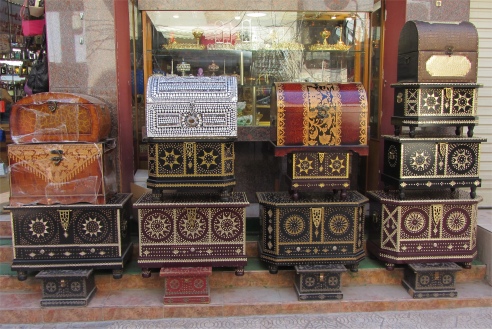
Mandoos (Wedding Dowry Chests)
|
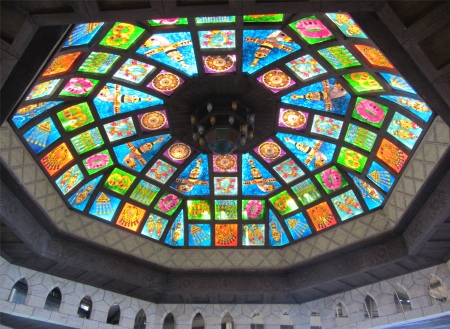
Souq Skylight
|

Souq Stalls
|
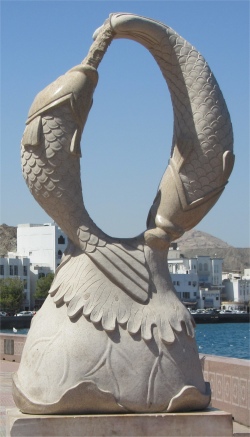
Fish Statue
|
All manner of western and traditional clothing could be bought here, and many of the clothing shops had men busy at work behind sewing machines; sewing appeared to be a man's job. Indeed the whole souq seemed to be run by men. All the shop owners were a cheery bunch, but I suppose they would be if they were after your money.
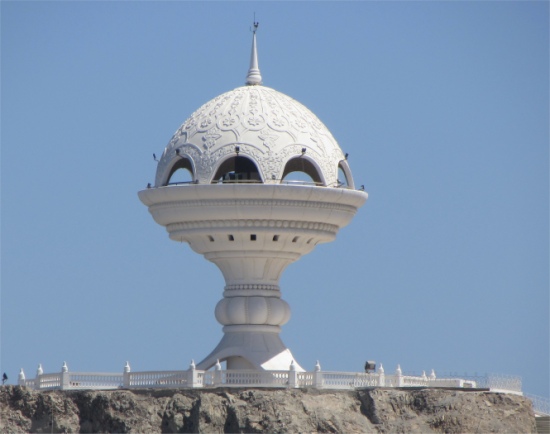
Giant Incense Burner
|
Like much of what I'd seen of Oman so far, the souq complex was modern, well lit and clean, with some beautiful skylights and cupolas. However, I soon get bored of shopping places, so I headed out and crossed over to the harbour wall and began my walk to Old Muscat.
The road followed a graceful curve around the harbour, passing below Mutrah Fort which sat on a small hill overlooking the harbour. When it was built in the 1580s by the Portuguese, it would have dominated the port. Sadly, it was not open to the public.
Continuing along the coastal road, I observed that for a lot of its length, the landward side was extremely lush with greenery and flowers, like a winding oasis. Within a short distance I came across the Gold Fish Monument and Fountains, where a row of water jets cavorted in a pseudorandom sequence. Hmmm... a useful distraction right on the verge of a tight bend in the road.
|
|
Another Harbour View (please use scroll bar)
|
I continued on my way, savouring the salty breeze wafting off the sparkling sea, a welcome relief from the baked streets of Ruwi. On my way I encountered a lush "designer" park, Al-Riyam Park, jammed packed with play facilities for children. It was a pity it was shut. A giant, white incense burner stood guard on a small hill above the park. A watchtower on the promontory jutting out into the sea would offer an ideal viewpoint. Sadly it was closed for repairs. I think I see a pattern developing here.

Muscat Gate
|
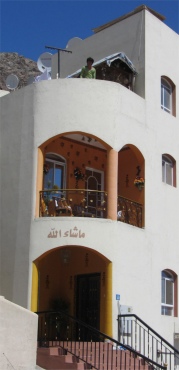
Old Muscat House
|
The road curved away and I lost sight of Mutrah. It passed Kalbuh Bay Park, closed, and took me up a long incline to reveal the grand entrance to Old Muscat, the Muscat Gate, which majestically straddled the dual carriageway. The gate marks the position of the old city wall, and was used in the past to keep land-based marauders out. The top of the gate contained a museum where I spent considerable time learning about the region's geology, its growth since 1970, the ports, heritage and the history of Oman's rulers. It was most informative, and the English translations were spot on.
|
|
Old Muscat Harbour, with the Sultan's Palace to the Right, and Al-Jalali Fort to the Left of It (please use scroll bar)
|
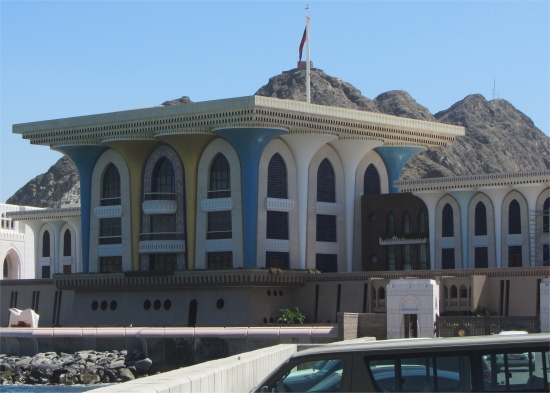
Sultan's Palace from Old Muscat Harbour
|
From here, it was a simple drop down the hill into the tiny, open-gated city of Old Muscat cradled around a natural harbour surrounded by a jagged spine of hills. I made a bee-line for the harbour wall, with Al-Mirani Fort high up on a hill to my left. This was built during the Portuguese occupation in the 1580s. Today it was undergoing major cosmetic surgery. Legend has it that the Portuguese commander fell for the daughter of a Hindu supplier, who refused a union between the two on religious grounds. However, when the supplier was threatened with ruin, he spent a year supposedly preparing for the wedding. In actual fact, he convinced the commander that the fort's supplies were in need of a complete overhaul. When the stored gunpowder and grain were removed, instead of replacing them, the supplier gave the signal to Imam Sultan bin Saif, who succeeded in retaking the defenceless fort in 1649. The Portuguese were ousted from Muscat soon after.
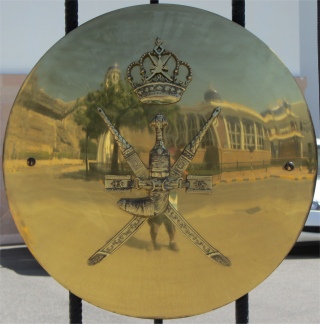
Coat of Arms
|
Once I had passed by the fort, and reached the sea wall, there at the head of the natural harbour stood the Sultan's Palace. The centre piece was a majestic building, whose walls contained gorgeous mushroom pillars of blue and gold. It was flanked by an array of stunning white buildings, the whole being a most magnificent affair. Modern gun emplacements, covered up by canvas, stood along its sea wall. This was definitely fit for a "king".
The palace was built over the site of the former British embassy, which had the stump of a flagpole in the grounds. The story has it that any slave who managed to touch the flagpole was granted freedom.
Over the inlet, on the far side of the palace, Al-Jalali Fort stood, guarding the eastern approaches to the harbour. It too was built by the Portuguese. Apparently, neither this fort nor Al-Mirani Fort were open to the public, although special dignitaries and heads of state did get a tour of Al-Jalali Fort.
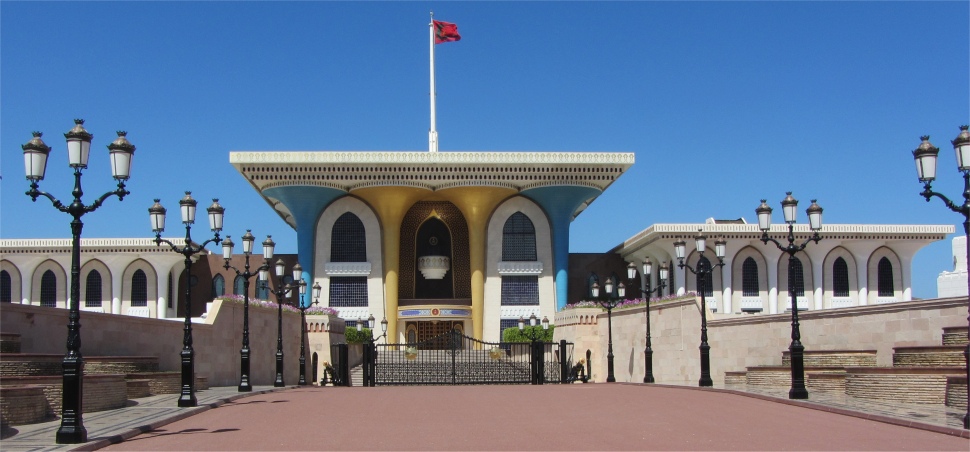
Palace Gates
|
Wandering around the extensive outside of the palace, I arrived at the impressive front, protected by its gate, just as Buckingham Palace is. And like London's Mall, here a Colonnade led back from the palace gates, through an avenue of palms flanked by grand royal court buildings. A most impressive affair indeed. The area bristled with royal guards.
Coaches pulled up by the roundabout at the Colonnade, and their passengers marched as army units up to the Palace gates for the quintessential photographs at the gates, and the marched back and continued on their whistle-stop journeys.
|
|
Colonnade Leading to Palace Gates, Flanked by Grand Royal Court Buildings (please use scroll bar)
|
I needed some respite from the heat, so I headed off to find a coffee shop, not too easy in Old Muscat I hasten to add. A Welsh couple took the next table to me. They hailed from an old village just outside Cardiff, and were on a cruise around the Arabian Peninsula, stopping off at Mutrah for two nights. They were touring around the area at their own pace using hop-on/hop-off tourist busses rather than a fixed coach trip, a far better compromise I thought. They too were impressed by the affluence and cleanliness of the area; it had all been a "bit of an eye-opener" for them. I shared with them tales of work I used to do in Cardiff. "When were you last there?" asked the man. "Oh, must have been 20 years or so ago," I replied. "You wouldn't recognise it now," he told me. "It has been totally transformed. You'd be amazed how many English accents are in the city nowadays. People from Bristol and around are coming in droves," he informed me. Sadly they had to move on, they had their schedule to keep, but they realised they were only touching the surface of what Oman has to offer in such a short stay.
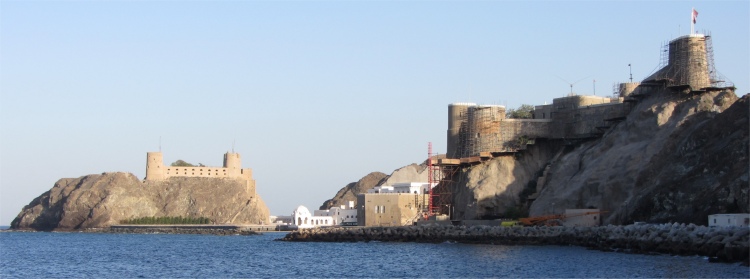
Al-Jalali Fort (Left) and Al-Mirani Fort (Right)
|
I too moved on, past the palace again and along the coastal road as far as the naval base, before I was forced back inland.
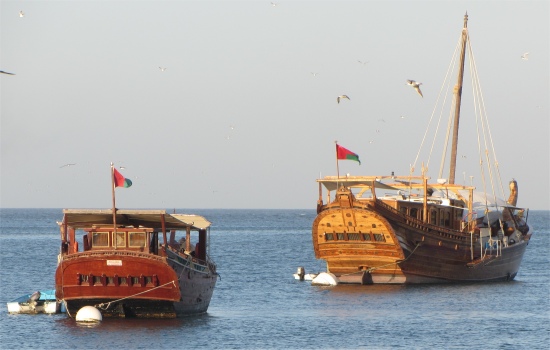
Mutrah Dhows
|
I ate back at Mutrah, and then approached a taxi rank. A gaggle of men in traditional dress were heatedly debating some point, and when I approached, a ringleader piped up, "You want a taxi?" "Yes, please, to Ruwi. How much?" I asked. Several pairs of eyes under wrinkled lids fixed upon my face. "Three Rial," was the reply. "Two," I stated. There was some huffing and puffing before I got the feedback, "Three Rial." My immediate response was, "It cost two Rial to get here, so two Rial back." Without any further argument we agreed on two.
A young chap was nominated as my driver, and off we went. "How are you?" asked the young man. "Zayn (fine)," I replied. "Oh, you speak Arabic," he continued rather surprised. "La (no)," I responded. He laughed out loud; wasn't that funny I thought. In our subsequent conversation, in English, I learned that many Indians come here to work since there is not much work for them back home. I detected a slight resentment. On the topic of the incredible heat I was encountering in Oman, he pointed out it was only 38 degrees today, but in summer it can reach 48 degrees. He had a pretty good command of English, and soon he learned of my plans in Oman, my trip to Tanzania, and I learned that five more oil fields and two more gas fields had been discovered in the country. "Many expats work here in the oil industry, and as teachers too," he told me. He nodded assent when I commented how rich the country seemed.
"Where did you learn English?" I asked, "School?" "I learn it here and there," he replied, "I only studied it for one year at school."
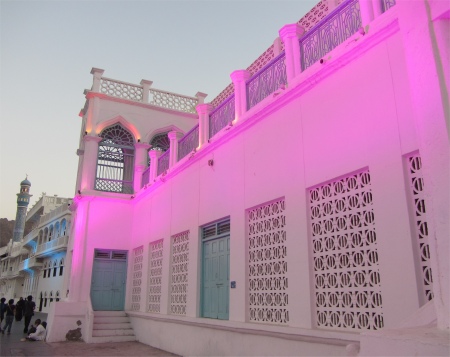
Mutrah Evening Scene
|
He asked where I came from in England, but his knowledge of U.K. geography was lacking. "I had a friend form Shiffield. Do you live far from Shiffield?" "Oh, I think you mean Sheffield. I live about three hours away." He continued, "I found it hard to understand him. he spoke very quickly." I laughed, "He probably had a thick Yorkshire accent too, which you would certainly have had difficulty with." I explained how the U.K. had a range of dialects, which was no different to any other country. I found the lad amiable and easy to talk to. I complemented him on his English. "I have a Canadian girlfriend," he chuckled, "but some people don't like my accent." He seemed genuinely concerned by this. As far as I was concerned, I could detect no Canadian lilt, and I told him so.
As we approached a roundabout on the outskirts of Ruwi, a policeman stepped out and pulled him over. There was a little joking banter between the two, a marked contrast to Tanzania where eye contact was taboo, and the policeman waved us on. Apparently spotlights under the car are illegal in Oman.
The lad delivered me safely, and gave me his card before we parted as friends.
It had been a long day, and I had done a lot of walking. My right foot was starting to give me problems. The foot which was meant to reject its batch of sea urchin spines, still carried the intruders, and the swelling was not receding. I could live with it until I got back to the U.K., but I would be grateful for a day or two off it.
|
Last updated 19.4.2013
|





















